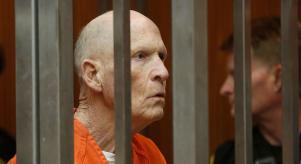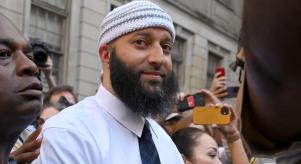
Killer Clown in court: The trial of John Wayne Gacy
Available on Crime+Investigation, Very Scary People (S1,E4) investigates the crimes of 'the killer clown' John Wayne Gacy.
Between 1972 and 1978, John Wayne Gacy killed at least 33 young men and boys in his home at 8213 W Summerdale Avenue in West Norwood Park Township, located in metropolitan Chicago, Illinois, United States.
Gacy had worked as a clown at children’s birthday parties, as well as operating his own remodelling business, P.D.M. Construction Co. He ran this business out of his unassuming home and it was under the pretence of employment that he lured his victims. Once inside, he would trick them into putting handcuffs on, sexually assault them, strangle them and then bury them in his crawl space, or dispose of them in the Des Plaines River.
He was finally apprehended after 15-year-old Robert Piest vanished on 11th December 1978. Gacy was identified as a suspect in the disappearance by Phillip Torf, Robert’s employer who knew he was meeting Gacy about a potential job. By the time investigators went to speak with Gacy, Robert was already dead, having been strangled and dumped in the river.
After investigators obtained a search warrant, they found some suspicious items in Gacy’s home, including handcuffs, fake badges, and a photo receipt from the drugstore where Robert had worked. (Chicago Sun-Times, 27 July 2021 – 'Investigating the Gacy Investigation') There wasn’t enough evidence for an arrest so investigators placed Gacy on surveillance. During surveillance, Gacy invited two of the investigators into his home and one believed that he smelled human decomposition. A second search warrant was executed.
Investigators and archaeologists embarked on Gacy’s home and unearthed 26 bodies buried in the crawl space. There were a further three bodies buried under the garage floor. Gacy admitted to disposing of four more in the river because he had run out of space at his home.
The bodies found in the crawl space were buried on top of one another and some were found with underwear stuffed in their mouths. When the corpses were unearthed, Gacy began to confess. As one investigator said: “He has confessed that he had sex with the boys and then strangled them.” (Fort Lauderdale News, 22 December 1978 – 'Authorities Fear up to 32 Bodies Are Buried Under Chicago Home')
John Wayne Gacy was ordered to stand trial on 33 murders; it was the largest number of murder charges brought against any single person in U.S. history at the time. (Albuquerque Journal, 6 February 1980 – 'Gacy Going on Trial in 33 Killings') It was decided by Cook County Circuit Judge Louis B. Garippo that the jury for the trial would be chosen in Winnebago County as opposed to Cook County. Gacy’s defence team suggested that it was impossible to get an unbiased jury due to the media coverage. (Detroit Free Press, 8 January 1980 – 'Outsiders Will Hear Gacy Trial') Testimony was expected to be so gruesome that spectators needed to be 16-years-old or older.
By 2nd February 1980, a jury consisting of seven men and five women was seated and the trial was ready to begin. (The Guardian, 2 February 1980 – 'Gacy Trial')
During opening statements, Prosecutor John Egan detailed the gruesome search in Gacy’s home, telling the jury: “Bodies and bodies and bodies. Day after day after day.” He said that as the bodies were unearthed, they were numbered while identifications were made. At the time of the trial, eleven of those bodies still remained unidentified.
Prosecutor Egan went into graphic detail about the final murder that Gacy committed: the murder of Robert Piest. He said that Robert was scared to tears, telling the courtroom: “Gacy said, ‘Don’t cry. I’m going to show you one more trick.’ He called it the rope trick.” (Fort Worth Star-Telegram, 7 February 1980 – 'Killing Described at Gacy Trial') He detailed how Gacy went behind Robert, who was handcuffed, and put a rope around his neck, tied two knots, and then slipped a stick through the knots to form a garrotte. Gacy strangled the teenage boy to death. He finished up his opening statements by bellowing: “If there is another man among us as evil as John Wayne Gacy, God help us all!” (The Philadelphia Inquirer, 8 February 1980 – 'High Evil, Low Tedium')
Gacy’s defence team, on the other hand, announced during their opening statements that Gacy was legally insane, with Robert Motta stating: “By any standards, legal, medical – any standards – John Wayne Gacy is insane. He is a deeply sick person. Possessed. You put yourself in that house and try to conceive of it, living there with all those bodies buried.”
Early on in the trial, the jury heard from the families of some of Gacy’s victims. They spoke about the last time they saw their sons. A number of them had met Gacy in the past because some of the victims had previously worked for him. In an attempt to counteract the insanity defence, they were asked about Gacy’s mannerisms, and all said he came across as a regular man. (The Miami Herald, 8 February 1980 – 'Mother of Teenager Collapses on Stand During Trial of Gacy')
Bessie Stapleton, whose 14-year-old son, Samuel, was found dead in Gacy’s crawl space, testified on day two of the trial. When she was handed a bracelet that was found on her son’s skeleton and asked to identify it, she became so overcome with emotion that she fainted and the trial needed to be momentarily halted.
The prosecution presented eyewitness testimony to link Gacy to the disappearance of Robert. Testimony was presented by Phillip Torf, who owned the drugstore where Robert had worked. He told the courtroom that Robert had been working in the store on the night that he vanished. He said that Gacy, who had remodelled the store the year beforehand, came in and started talking about another project. Torf stated: “Gacy mentioned that it looked like we had a new crew,” while staring at Robert. Gacy then approached Robert, offering to give him a high-paying construction job at his business, and lured him back to his home. (The Bradenton Herald, 10 February 1980 – 'Gacy Rebuked Policemen')
David Cram, who had worked at Gacy’s construction business, revealed during the trial that some of the boys and young men who had worked with Gacy had been the ones to dig the graves in the crawl space; they believed that they were digging drainage trenches. (The Daily Chronicle, 13 February 1980 – 'Witness Says Gacy Made Him Dig Graces')
Tony Antonucci took the jury through the terrifying moment that Gacy tried the handcuff trick on him. The prosecution presented a pair of silver handcuffs and a four-foot restraining board, as Tony said to the jury that he had been handcuffed by Gacy at his home during a “living room wrestling match”. He managed to overpower Gacy, get the handcuffs off and place them on Gacy instead. Gacy allegedly told him: “You’re the only one that not only got out of the handcuffs but put them on me.” (Muncie Evening Press, 12 February 1980 – 'Youth Tells of Beating Gacy Handcuff Trick')
Some testimony focused on Gacy’s confessions. His best friend, Ronald E. Rohde, told the courtroom that Gacy had cried as he told him that he had been “a bad boy… I’ve killed 30 people, give or take a few.” There was also testimony from an investigator that Gacy told them that he had buried bodies “all over the property”. (Hartford Courant, 15 February 1980 – 'Friend Claims Gacy Admitted Mass Murders')
After all of the prosecution evidence was presented, the defence presented their case. They wanted to sway the jury into believing that Gacy was legally insane at the time of the murders. Gacy had repeatedly made references to multiple personalities and this provided the groundwork for the defence. He had told investigators that there were “four Johns” inside of him and said that there was one named Jack who committed the murders because he was homophobic. (The Herald, 18 February 1980 – 'Defense May Capitalize on Multiple Personality')
Prosecutors contended that the normalcy Gacy portrayed while out in public was evidence that he was legally sane. Defence attorneys, however, argued that he had a “hidden side” that compelled him to kill.
The prosecution called on Dr. Robert Reifman, who testified that Gacy had tried to pretend to him that he had multiple personalities in a bid to support the insanity defence. Psychiatrists hired by the defence rebuffed this, stating it was their belief that Gacy was severely mentally ill. According to Dr. Reifman, however, Gacy did not meet the legal test of insanity. (The Tampa Times, 6 March 1980 – 'Psychiatrists Says Gacy Merely Wanted to be Famous')
In an attempt to create a mitigating factor, the defence also called on Gacy’s mother, Marian Gacy, to portray a stark picture of family life for him growing up. She revealed that Gacy’s father frequently beat him. She said that he was a mean drunk and when he harmed Gacy, he never fought back because he loved his father. She also said that during high school, Gacy frequently passed out and he was diagnosed as having epilepsy. (The Indianapolis Star, 26 February 1980 – 'Mother Says John Gacy Was Beaten by Father')
During closing arguments, Prosecutor Egan said that when surveillance was being conducted, Gacy had commented to an investigator: “Clowns can get away with murder.” He said that this comment, and other similar ones, showed that Gacy knew the net was closing in on him and likened him to “a rat trapped in a corner”. (The Palm Beach Post, 14 February 1980 – 'Clown Gacy Bragged to Officer')
Ultimately, the jury rejected the defence’s claims of insanity and after deliberating for less than two hours, they found John Wayne Gacy guilty of 33 murders, sexual assault, and taking indecent liberties. (The Herald Palladium, 13 March 1980 – 'Death Sentence Asked for Killer Gacy') Gacy was sentenced to death. On 9th May 1994, that sentence was carried out via lethal injection. His last words were: “Kiss my ass.”
To this day, five of John Wayne Gacy’s victims remain unidentified.
Very Scary People, chronicles the twisted lives of some of the most frightening, diabolical characters in recent history. Hosted by Donnie Wahlberg the series looks at the horrific killings of Charles Manson, Aileen Wuornos, John Wayne Gacy, the Rev Jim Jones, and many others.




